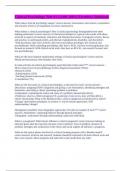Exam (elaborations)
Clinical Psychology Test #1 || with 100% Errorless Solutions.
- Course
- Institution
What makes clinicial psychology unique? correct answers Assessment, intervention, consultation and research. There is an integration of science and practice. What defines a clinical psychologist? How is clinical psychology distinguished from other helping professions? correct answers A clinical ...
[Show more]



